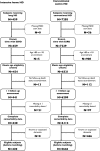Intensive hemodialysis associates with improved survival compared with conventional hemodialysis
- PMID: 22362910
- PMCID: PMC3312510
- DOI: 10.1681/ASN.2011070676
Intensive hemodialysis associates with improved survival compared with conventional hemodialysis
Abstract
Patients undergoing conventional maintenance hemodialysis typically receive three sessions per week, each lasting 2.5-5.5 hours. Recently, the use of more intensive hemodialysis (>5.5 hours, three to seven times per week) has increased, but the effects of these regimens on survival are uncertain. We conducted a retrospective cohort study to examine whether intensive hemodialysis associates with better survival than conventional hemodialysis. We identified 420 patients in the International Quotidian Dialysis Registry who received intensive home hemodialysis in France, the United States, and Canada between January 2000 and August 2010. We matched 338 of these patients to 1388 patients in the Dialysis Outcomes and Practice Patterns Study who received in-center conventional hemodialysis during the same time period by country, ESRD duration, and propensity score. The intensive hemodialysis group received a mean (SD) 4.8 (1.1) sessions per week with a mean treatment time of 7.4 (0.87) hours per session; the conventional group received three sessions per week with a mean treatment time of 3.9 (0.32) hours per session. During 3008 patient-years of follow-up, 45 (13%) of 338 patients receiving intensive hemodialysis died compared with 293 (21%) of 1388 patients receiving conventional hemodialysis (6.1 versus 10.5 deaths per 100 person-years; hazard ratio, 0.55 [95% confidence interval, 0.34-0.87]). The strength and direction of the observed association between intensive hemodialysis and improved survival were consistent across all prespecified subgroups and sensitivity analyses. In conclusion, there is a strong association between intensive home hemodialysis and improved survival, but whether this relationship is causal remains unknown.
Figures



Comment in
-
Intensive hemodialysis: back to the beginning?J Am Soc Nephrol. 2012 Apr;23(4):573-5. doi: 10.1681/ASN.2012020216. Epub 2012 Mar 15. J Am Soc Nephrol. 2012. PMID: 22423013 No abstract available.
-
The eternal (nocturnal) quest for better dialysis outcomes.J Am Soc Nephrol. 2012 Apr;23(4):571-3. doi: 10.1681/ASN.2012020210. Epub 2012 Mar 15. J Am Soc Nephrol. 2012. PMID: 22423014 No abstract available.
References
-
- Saran R, Bragg-Gresham JL, Levin NW, Twardowski ZJ, Wizemann V, Saito A, Kimata N, Gillespie BW, Combe C, Bommer J, Akiba T, Mapes DL, Young EW, Port FK: Longer treatment time and slower ultrafiltration in hemodialysis: Associations with reduced mortality in the DOPPS. Kidney Int 69: 1222–1228, 2006 - PubMed
-
- Foley RN, Parfrey PS, Sarnak MJ: Epidemiology of cardiovascular disease in chronic renal disease. J Am Soc Nephrol 9[Suppl]: S16–S23, 1998 - PubMed
-
- Weinreich T, De los Ríos T, Gauly A, Passlick-Deetjen J: Effects of an increase in time vs. frequency on cardiovascular parameters in chronic hemodialysis patients. Clin Nephrol 66: 433–439, 2006 - PubMed
Publication types
MeSH terms
Grants and funding
LinkOut - more resources
Full Text Sources
Other Literature Sources
Medical

